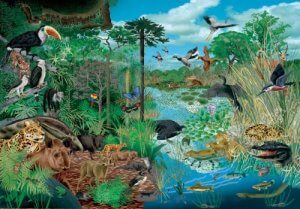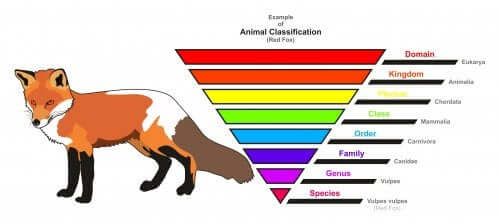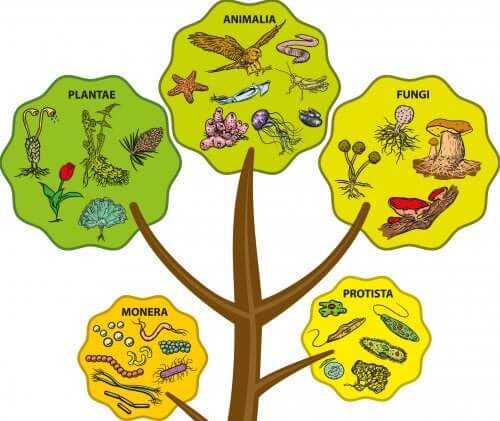The 5 Kingdoms of Living Things for Children

It’s very important to instill in children a love for nature and respect for the environment. But in order for that to happen, kids need to learn about our planet first. Not all children are lucky enough to live in the countryside – or even have access to a backyard. But when you can escape to the great outdoors, we’ll help you offer a simple explanation of the 5 kingdoms of living things, which your children can observe while outside.
Until the 19th century, all living things were divided into two large kingdoms: Animalia and Plantae. However, since that time and with the help of new observation technologies, scientists have discovered many new living things. But not all of them – like fungus and bacteria – fit into the two existing kingdoms.
Therefore, in 1985, Lynn Margulis together with V. Schwarts decided to take R. Whittakker’s 1969 5-kingdom classification and readapt it. The final product included the following: Monera (bacteria), Protista, Fungi, Plantae, and Animalia.
What are the 5 kingdoms of living things? How are living things organized?
In biology, each kingdom represents a great subdivision of living things according to certain taxonomic characteristics and the evolutionary relationship among them. In other words, in order for an organism to belong to a specific kingdom, it must possess the general and shared characteristics of the kingdom.
So, although a squirrel and a shark may seem to have nothing in common, they actually belong to the same group. That is the Animal Kingdom. At the same time, each kingdom contains different categories or taxons in order to classify its members. These six taxonomic categories are the following:
- Phylum
- Classe
- Order
- Family
- Genus
- Species

The last taxonomic category, species, is what determines who we are. It’s the identity of all the individuals that belong to this classification. Scientists have chosen words with Greek and Latin origins to give each species its scientific name.
We have Swedish explorer Carolus Linnaeus to thank for this binomial nomenclature. Linnaeus was a naturalist, scientist, botanist, and zoologist in the 18th century.
The 5 kingdoms of living things for children
Kingdom monera
Bacteria, archaea, and microplasmas belong to this kingdom. Antonie van Leeuwenhoek was the first to observe bacteria in the 17th century, which he called “animalcules.” Archaea are the oldest living organisms on the planet, having been around for some 3800 million years. Members of this kingdom share the following characteristics:
- These are unicellular prokaryotes because they don’t have a nucleus.
- They can live in the most diverse and extreme habitats that you can imagine. They can live alone or by forming colonies and can even live inside our bodies.
- Some are beneficial while others cause illnesses.
- They’re microscopic beings measuring between 0.2 and 0.3 microns in diameter.
- Their morphology can be round, long, comma-shaped, or cork-shaped.
Kingdom Protista
This kingdom is a bit of a mixed bag. Every organism that doesn’t fit into the other four kingdoms ends up here. Kingdom Protista encompasses both unicellular and pluricellular organisms. It includes protozoa and algae, which are very different from one another. However, there are certain characteristics that define the members of this diverse group.
- They normally cluster in colonies although they aren’t very specialized or differentiated.
- Some can move around thanks to some structures (organelles) called cilia or flagella. These are small tales that act like rotors.
- Protozoa live in water, in the ground, and inside other organisms, causing illnesses like Trypanosoma brucei, which is responsible for African sleeping disease.
- Algae live in oceans, rivers, and other bodies of water, forming part of marine plankton or attached to rocks. They can become symbiotic with fungi and form organisms called lichens.

Kingdom fungi
Fungi is another one of the five kingdoms of living things. Some fungi are also known as mushrooms, and these can be delicious – like the Boletus edulis. Others can be extremely poisonous, like the Amanita muscaria or toadstools.
- In this group, we find pluricellular organisms, like fungi, or unicellular organisms, like yeast.
- They attach to one spot but they especially like moist areas.
- They’re responsible for decomposing organic material and dead beings. Therefore, their work plays a very important role in nature, returning important nutrients to the earth.
- At the same time, yeasts are very important to the food industry. Thanks to them, we can produce bread and beer.
Reino Plantae
This kingdom is made up of all of the different plants that inhabit the earth. It includes the largest trees on the planet, like Sequoias that reach over 300 feet high. And it also includes the tiniest ones, like the Wolffia, which measures only 1.3mm.
- They’re pluricellular and are able to produce their own food thanks to sunlight. This process is known as photosynthesis.
- They live in the ground but respond to the stimulus of light and slowly move towards it.
- They supply oxygen to the atmosphere, which is essential to life on earth.
Kingdom Animalia
This is the broadest group of all the kingdoms. Animals inhabit every part of our planet, including oceans, jungles, and deserts. They consist of invertebrates, like butterflies, Chondrichthyes (sharks, for example), and vertebrates, like human beings.
- Animals are pluricellular eukaryotes, possessing a nucleus in the interior of their cells.
- They breathe in the oxygen that plants produce.
- Animals are able to move, at least within the environment they inhabit.
- They feed off of other organisms and are unable to produce their own food.
- Their diet is quite varied. Animals can be: herbivores, carnivores, omnivores, insectivores, detritivores, or parasites.
Conclusion on the 5 kingdoms of living things…
We hope the information you’ve found here is useful as you teach your children about the five kingdoms of living things. What’s more, we hope it helps you and your family appreciate and enjoy nature even more than before.
“That love of living things is man’s most noble attribute.”
It’s very important to instill in children a love for nature and respect for the environment. But in order for that to happen, kids need to learn about our planet first. Not all children are lucky enough to live in the countryside – or even have access to a backyard. But when you can escape to the great outdoors, we’ll help you offer a simple explanation of the 5 kingdoms of living things, which your children can observe while outside.
Until the 19th century, all living things were divided into two large kingdoms: Animalia and Plantae. However, since that time and with the help of new observation technologies, scientists have discovered many new living things. But not all of them – like fungus and bacteria – fit into the two existing kingdoms.
Therefore, in 1985, Lynn Margulis together with V. Schwarts decided to take R. Whittakker’s 1969 5-kingdom classification and readapt it. The final product included the following: Monera (bacteria), Protista, Fungi, Plantae, and Animalia.
What are the 5 kingdoms of living things? How are living things organized?
In biology, each kingdom represents a great subdivision of living things according to certain taxonomic characteristics and the evolutionary relationship among them. In other words, in order for an organism to belong to a specific kingdom, it must possess the general and shared characteristics of the kingdom.
So, although a squirrel and a shark may seem to have nothing in common, they actually belong to the same group. That is the Animal Kingdom. At the same time, each kingdom contains different categories or taxons in order to classify its members. These six taxonomic categories are the following:
- Phylum
- Classe
- Order
- Family
- Genus
- Species

The last taxonomic category, species, is what determines who we are. It’s the identity of all the individuals that belong to this classification. Scientists have chosen words with Greek and Latin origins to give each species its scientific name.
We have Swedish explorer Carolus Linnaeus to thank for this binomial nomenclature. Linnaeus was a naturalist, scientist, botanist, and zoologist in the 18th century.
The 5 kingdoms of living things for children
Kingdom monera
Bacteria, archaea, and microplasmas belong to this kingdom. Antonie van Leeuwenhoek was the first to observe bacteria in the 17th century, which he called “animalcules.” Archaea are the oldest living organisms on the planet, having been around for some 3800 million years. Members of this kingdom share the following characteristics:
- These are unicellular prokaryotes because they don’t have a nucleus.
- They can live in the most diverse and extreme habitats that you can imagine. They can live alone or by forming colonies and can even live inside our bodies.
- Some are beneficial while others cause illnesses.
- They’re microscopic beings measuring between 0.2 and 0.3 microns in diameter.
- Their morphology can be round, long, comma-shaped, or cork-shaped.
Kingdom Protista
This kingdom is a bit of a mixed bag. Every organism that doesn’t fit into the other four kingdoms ends up here. Kingdom Protista encompasses both unicellular and pluricellular organisms. It includes protozoa and algae, which are very different from one another. However, there are certain characteristics that define the members of this diverse group.
- They normally cluster in colonies although they aren’t very specialized or differentiated.
- Some can move around thanks to some structures (organelles) called cilia or flagella. These are small tales that act like rotors.
- Protozoa live in water, in the ground, and inside other organisms, causing illnesses like Trypanosoma brucei, which is responsible for African sleeping disease.
- Algae live in oceans, rivers, and other bodies of water, forming part of marine plankton or attached to rocks. They can become symbiotic with fungi and form organisms called lichens.

Kingdom fungi
Fungi is another one of the five kingdoms of living things. Some fungi are also known as mushrooms, and these can be delicious – like the Boletus edulis. Others can be extremely poisonous, like the Amanita muscaria or toadstools.
- In this group, we find pluricellular organisms, like fungi, or unicellular organisms, like yeast.
- They attach to one spot but they especially like moist areas.
- They’re responsible for decomposing organic material and dead beings. Therefore, their work plays a very important role in nature, returning important nutrients to the earth.
- At the same time, yeasts are very important to the food industry. Thanks to them, we can produce bread and beer.
Reino Plantae
This kingdom is made up of all of the different plants that inhabit the earth. It includes the largest trees on the planet, like Sequoias that reach over 300 feet high. And it also includes the tiniest ones, like the Wolffia, which measures only 1.3mm.
- They’re pluricellular and are able to produce their own food thanks to sunlight. This process is known as photosynthesis.
- They live in the ground but respond to the stimulus of light and slowly move towards it.
- They supply oxygen to the atmosphere, which is essential to life on earth.
Kingdom Animalia
This is the broadest group of all the kingdoms. Animals inhabit every part of our planet, including oceans, jungles, and deserts. They consist of invertebrates, like butterflies, Chondrichthyes (sharks, for example), and vertebrates, like human beings.
- Animals are pluricellular eukaryotes, possessing a nucleus in the interior of their cells.
- They breathe in the oxygen that plants produce.
- Animals are able to move, at least within the environment they inhabit.
- They feed off of other organisms and are unable to produce their own food.
- Their diet is quite varied. Animals can be: herbivores, carnivores, omnivores, insectivores, detritivores, or parasites.
Conclusion on the 5 kingdoms of living things…
We hope the information you’ve found here is useful as you teach your children about the five kingdoms of living things. What’s more, we hope it helps you and your family appreciate and enjoy nature even more than before.
“That love of living things is man’s most noble attribute.”
All cited sources were thoroughly reviewed by our team to ensure their quality, reliability, currency, and validity. The bibliography of this article was considered reliable and of academic or scientific accuracy.
- Alvargonzález, D. (1992). El sistema de clasificación de Linneo. Pentalfa. Disponible en este enlace
- Madigan, M. (mayo 2015). Brock, biología de los microorganismos. Editorial Pearson.
This text is provided for informational purposes only and does not replace consultation with a professional. If in doubt, consult your specialist.








